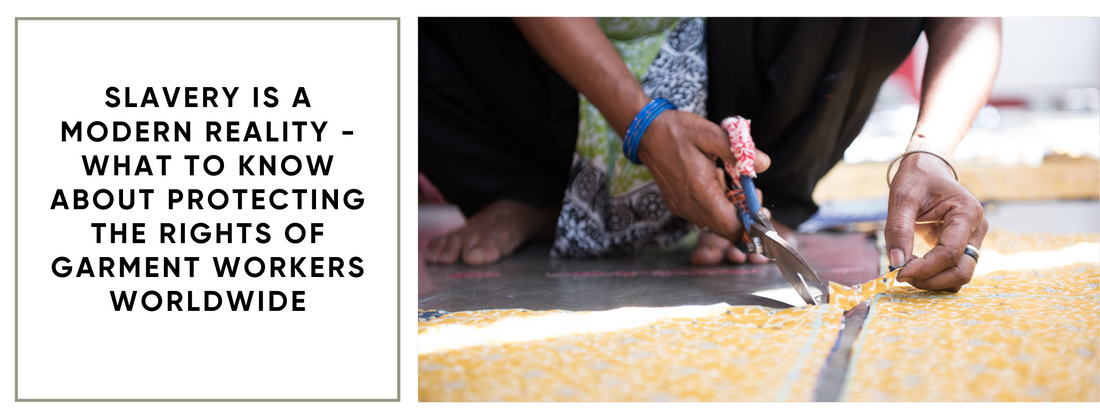
Slavery Is A Modern Reality - What To Know About Protecting The Rights of Garment Workers Worldwide
Share
Today is the International Day for the Abolition of Slavery – if you thought slavery was a thing of the past, we are still fighting to end it. Although slavery is prohibited worldwide through international laws protecting human rights, tragically these laws are not always followed and enforced.
According to the International Labour Organization, in 2021, an estimated 27.6 million people were in forced labor. This includes 23% in commercial sexual exploitation, 63% in various other private sectors, and 14% in state-forced labor. Migrant workers are more than three times more likely to be forced into labor than others.
Anti-Slavery International defines modern slavery as any instance in which “an individual is exploited by others for personal or commercial gain.” This may occur through force, coercion, or deception. Today, slavery is most common in industries that require heavy, lower-skilled labor and that inadequately regulated.
Modern slavery takes many forms, including:
- Traditional slavery, in which a person is born into slavery, and spends the rest of their life as property for the families who “own” them.
- Forced labor, which is when work occurs under threats, penalty, or intimidation.
- Debt bondage, which in many instances can be debt that is inherited and passed down to the worker’s children that they have to work off before being freed of the debt.
- Serfdom, in which a person is forced to work on someone else’s land and unable to change their work status.
- Sale of children, who are then forced to work in dangerous and harmful situations like quarries, domestic labor, sex work, or forced begging.
Modern slavery can occur in many different types of industries including mining, construction, domestic work, or manufacturing, like in the garment industry. For example, it can look like a female garment worker with an unsafe employer, locked in a factory for long hours to labor for painfully low wages in abusive and dangerous working conditions. Sadly, of the roughly 75 million workers in the global fashion industry, as many as 85% are women, and women are most likely to be the victims of slavery in this industry.
Garment ethics issues can even extend to the materials used to make the garments – and this is a point of particular concern in light of the US’s recent ban on cotton grown in Xinjiang, China. A recent report by the United Nations Human Rights Office of the High Commissioner confirmed what many already strongly suspected: forced labor among Uyghur cotton farmers. Last year, oppressive treatment of Uyghurs, an ethnic minority group in China, prompted the US to pass the Uyghur Forced Labor Prevention Act, a bill aimed at avoiding imports of products produced through forced labor in Xinjiang.
The UN report suggested that Uyghur forced labor may be considered “crimes against humanity” and urged Xinjiang businesses to take “all possible measures” to protect human rights. The closed-door nature of Xinjiang factories and farms – a tactic used in many circumstances of modern slavery – meant that international investigations into labor safety were slow and difficult.
It’s a chilling reminder of the importance of understanding every step of a brand’s supply chain, because each part of the production process has the potential for mistreatment or slavery, because the issue remains painfully relevant in our modern world.
Thankfully, global awareness and action against slavery has come a long way and progress continues to be made. In particular, the fashion industry has been active in promoting more transparency of their supply chains and setting standards for protecting the workers in these supply chains.
TO THE MARKET’s mission is to help businesses and consumers around the world harness their purchasing power for good. This includes ensuring that all products we source from them come from the most ethical and sustainable supply chains.
The makers that we work with go through our proprietary vetting process (T.R.A.C.E) which is an acronym that stands for the five characteristics we look for in partner suppliers: Transparent, Responsible, Authentic, Conscious, and Ethical.
We work with makers that can provide industry best practice certifications and who perform well in third party audits. Some of the most common certificates held by our suppliers include those for: SA8000 Standard - Social Accountability, Global Organic Textiles Standard (GOTS), Fair Trade Certified, WRAP Compliance, and Certified B Corporation (B Corp).
Suppliers also have to agree to our Guiding Principles, which are centered on the lawful and fair treatment of workers in the supply chain. We are also regularly conducting third party audits as well as site visits with strategic suppliers, to ensure they remain dedicated to these Guiding Principles.
Today we are reminded to continue to fight to end modern slavery - which includes reflecting on our supply chain.
